Lately, I have been thinking about cookbooks and recipes. This started a few months ago as I was clearing out my mother-in-law’s home. It’s funny how in a way I have gotten to know her better in death than in the 35 years that our time on the is planet intersected. To be fair she was a very private woman. I venture to say nobody that was close to her felt truly let in. As we’ve found her leavings, we find more of her is revealed to us. Christopher described feeling like we have been looking at an oil painting that we thought was one thing but in having it cleaned we are seeing it in totally different hues. Our brains are now trying to make sense of this new image.
In every space, in every nook, on every horizontal surface, I found recipes. Recipes written on loose-leaf paper, recipes written on cards, recipes compiled into organized binders, and recipes compiled in notebooks or journals. I found a cigar box of clipping from as early as the 1940s when she was a child, unfortunately, this box was to mildewed to save, or maybe fortunately as that made the decision easy. (How much to keep being a whole other musing.) The oldest notebook I found of recipes is dated 1958 from when she was 17. She owned very few cookbooks; a couple of editions of Better Homes and Gardens and our fermentation books. From what we saw in her spaces, she wasn’t a piler, but I found envelopes of recipes in drawers, boxes of recipes in the boxes of photo albums, a couple of years of Taste of Home magazines from the 1980s with her cross-stitch magazines, plastic grocery sacks with recipes in clothes closets, even recently transcribed recipes on the table next to where she sat. There were no recipes in the kitchen. Many of the handwritten recipes were repeats—same recipe different time.

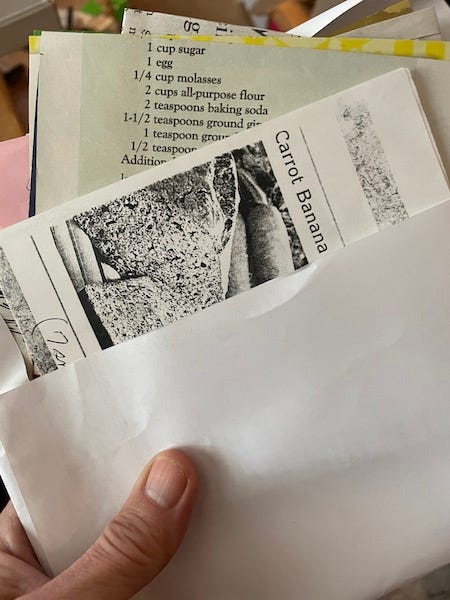
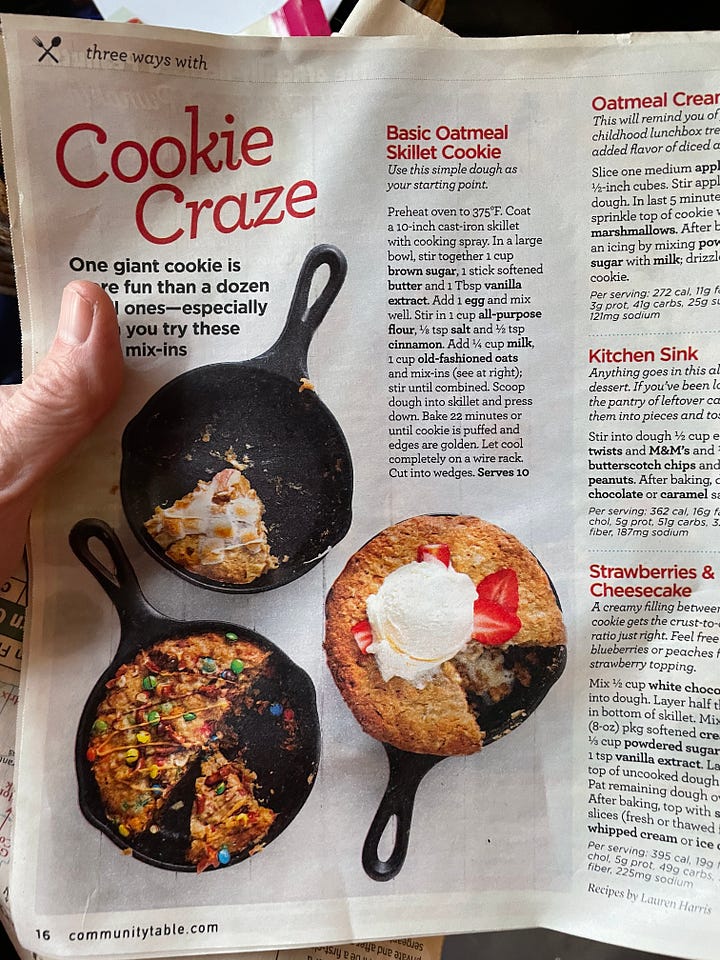
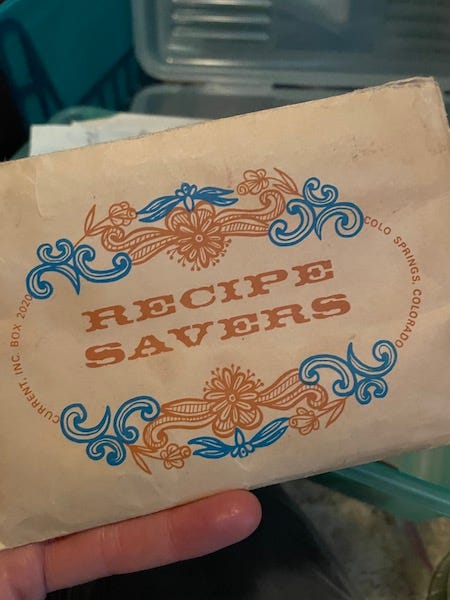
Okay, here is the thing. She did not cook more than a few dozen dishes, ever. The only times she tried new recipes was when, in our early twenties, we were vegetarian, and she hid pork chops under rice thinking we wouldn’t notice. That didn’t work. Years later, when I was staying away from gluten and she made a GF chocolate cake. It was good, she hated it. She served the same foods together always. I remember once Christopher’s brother said she’d served jello with something or another when they were kids. She corrected him, naming the only menu jello would have gone with. She loved sweets. She made the same pies, the same Christmas cookies, and the same desserts throughout the years. Despite simple flavors, salt and pepper mostly, and lack of culinary adventure there was a certain comfort in knowing what you would eat every time you visited. She made rustic hand-rolled egg noodles cooked in canned broth served over mashed potatoes that I think our children will feel is the essence of their grandma’s cooking, her love, and her home.
And so, we look at the small box of her collections we kept and the black trash bag full that we didn’t and wonder. We don’t even pretend to understand but we imagine that she was someone who dreamed of a self that was culinarily adventurous.
Cookbooks
Meanwhile, I have shelves and shelves of beautiful cookbooks in the kitchen and the living room. What might someone who doesn’t know me think it means? Most of these books I have read to some extent, many cover to cover, most of which I have also never followed a recipe from, some of which I look at regularly to get encouragement when I can’t think about what I want to prepare. Some of which I used a lot when I was young and now are just battered and abandoned like The Velveteen Rabbit.
I think seeing cookbooks on my shelves gives me comfort or some kind of satisfaction, I guess I haven’t unpacked that yet myself. Except for my fermentation collection, which comes from a place of keeping up with the developing genre, general type nerdiness around the subject, and supporting my fellow authors. I’ve been inspired often and almost followed recipes but my practical nature (I don’t have that ingredient and I am not driving the 35 miles to get it) and my general freewheeling approach tend to quickly send me off course. In the last year, I have come back full circle to follow recipes, as they are written here and there. I admit it makes cooking much more exhausting for me. Yet, as when I was younger, I have learned new techniques, and tasted new flavor combinations, that delight me and admittedly enrichen my usual off-the-cuff approach. In revisiting these books, I hope to pass along most, write notes in others (which might very well be, I have this book because of x, y, or z but please don’t feel any need to keep), so that the sorting of my leavings my children will face someday a bit easier. To be clear this is the optimistic expectation I have of myself the truth may be that I am still sorting out my relationship with my cookbooks.
When we wrote our first cookbook, Fermented Vegetables, and were going through the many rounds of edits one does, we started to question our A to Z organization of the vegetables at C. Christopher and I still refer to “getting through the C’s” when we feel like some task we are doing will never end. The poster child of soured vegetables across the planet is cabbage and its varieties, so right there it is a bulk of recipes but wasn’t until that book that we became aware that there are so many vegetables that begin with the letter C, which made choosing a vegetable, or other ingredient, to highlight this week fun and daunting. Do I choose chocolate, chicory or citrus? Carrots or celery? Cabbage, cauliflower, cardoons, chard, celeriac, chili peppers, cucumbers, collards, corn, okay you get the point.
Calendar
In the theme of C my calendar of events is beginning to come together for 2023. This past week we finalized a 5-day fermentation retreat on Cortes Island, BC Canada. I will be teaching with my longtime friend and culture sister Katherine Lukas-Damer at Hollyhock retreat center. (I have to admit I am pretty excited about this one.)
Citrus
I chose citrus, mostly because I have been somewhat obsessed with preserved lemons and grapefruit peel vinegar the last few years and it is citrus season in the Northern Hemisphere. For me, citrus season is a chance to use dehydration and fermentation (and sometimes a combination of both) to make the most of these fruits. To be fair, I live close enough to one of the US growing regions of California. So near in fact that we can grow Meyer Lemons under protection. But when that protection in the form of a high-tunnel gets blown off by the wind, followed by the once every few years dip below 10°F the year of the first real harvest—a half a bushel—you realize you can’t really grow citrus. I am still feeling a little salty about this happening last winter. We are also still enjoying what is left of that harvest in the form of preserved lemons that are fermented. Preserved lemons, limes, or other citrus will allow you to add that bright tang to any meal even when these fruits have been shipped from far away and are unaffordable.
If you live in the regions where citrus grows you know that there are many trees in cities that go unpicked. In the spirit of less waste of food how lovely if some of these fruits could be enjoyed and preserved. Many people are happy to have someone take some or part of the fruit that they may see as messy.
These fruits can be simply salt preserved as is, they can be fermented with rich spices and oil as condiments like achar, they can be salted and dried to make a spice like black limes (recipe in Thursday’s paid subscription along with a lemon peel spicy date paste recipe and what to do with them once you have them), you can use the juice and preserve the peels in many ways. One of the easiest is to slice off the zest and dry it, keep it airtight, and grind in a spice grinder (coffee grinder) when you are ready to use.
Simple salt-preserved lemons, limes or other citrus don’t require much of a recipe. It is more of a process of fairly heavily salting them, making sure there is enough juice over the top, and carrying on as with any lactic acid ferment. I will include a general recipe at the end of this email for reassurance. If you make some be sure to share your thoughts in the comments.
I often get asked, are preserved lemons fermented? Or how can lemons be fermented when they start out so acidic and salty?
Yes, salt preserved lemons are fermented. While the salt levels are higher than most ferments, I think they need to be because citrus is so prone to yeast and mold. The levels still are not within a range that would kill all lactic acid bacteria (LAB.) Higher salt slows down and controls the fermentation which is to say it keeps the competing microbes at bay. The same goes for the acid level. LAB is a vast and varied group of bacteria. There are members of this group who would not survive this highly acidic environment but there are many who will not only survive but thrive. They will consume the starches and convert the entire citrus into a transformed ingredient—one with deep flavors, interesting muted bitters from the pith, and a little funk.
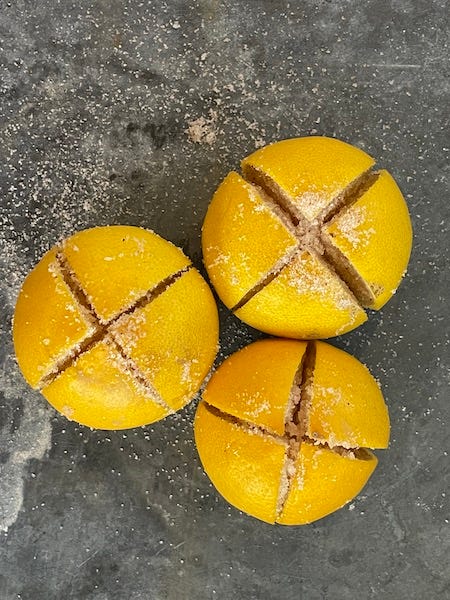
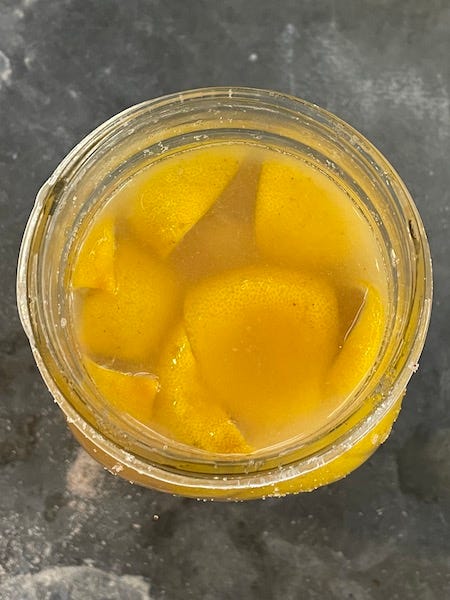
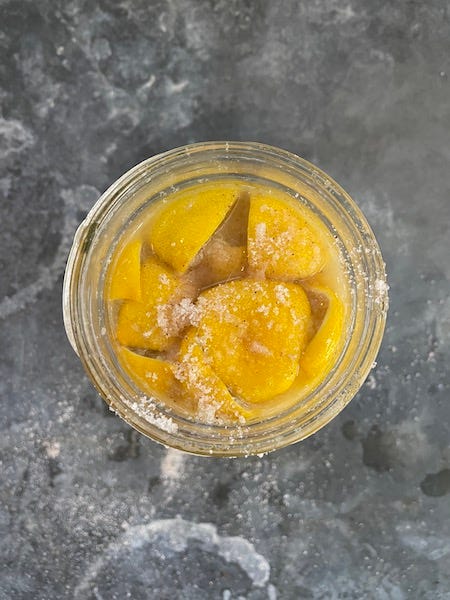
Preserved Citrus
Adapt this process for any citrus. While the salt may seem high, remember you will use just a small amount of these concentrated citrus bombs in your dish. It is always a good idea to remember to salt your dish after you have added flavorful ferments so that you can adjust accordingly.
8 whole lemons, or equivalent in any other citrus 12 limes for example
1/2 to 1 cup (136 -273 g) unrefined salt, plus 2 tablespoons (34 g) for the top
Freshly squeezed citrus juice, as needed
1. Rinse citrus in cold water. Trim about ¼ inch from the tip of each, if lemons. Cut the citrus as if you were going to slice them in half lengthwise, starting from the tip, but end the cut before you’re all the way through; cut in the other direction, so the lemons are in quarters but still attached at the base. Remove the seeds now or later as you use them. Rub generous amounts of salt in and around each piece of fruit.
2. Pack the fruit in a jar or crock, pressing so juice rises to the top. Make sure they are all submerged in the juice brine. To fill to the brim and ensure immersion, add freshly squeezed citrus juice as needed. Sprinkle 2 tablespoons of salt over the surface. Follow instructions for your vessel; for a jar, use burping method make sure there is little airspace and seal lid tightly. Burp as needed.
3. Set on counter, out of direct sunlight, for 21 to 60 days. Check periodically to make sure the lemons stay submerged.
4. This will be ready after 21 days but can go longer if you like. Taste and decide; the changes are in the richness of the thick brine and infusion of the zesty flavor. The peels will continue to soften.
5. To store, tamp down to make sure everything is submerged in brine, keep a round of parchment paper on top. Screw on the lid, then store in the fridge. This will keep, refrigerated, indefinitely.





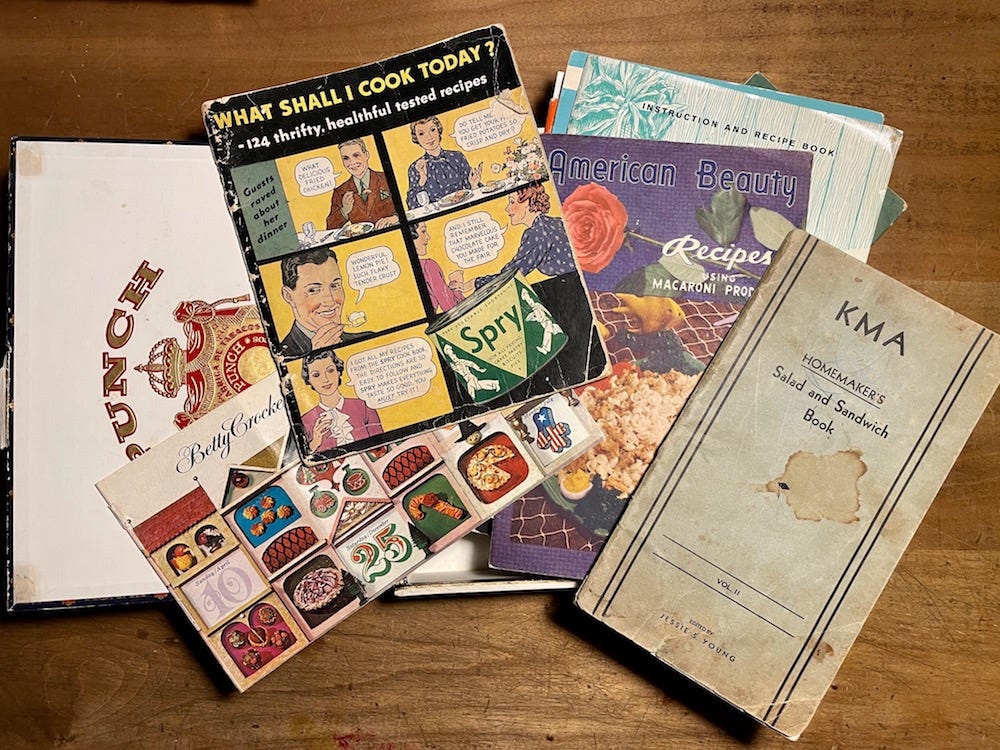
Concerning seeds in fermented lemons... we have found that the pectin in citrus seeds over time turns the 'juice' to jelly... this seems to maintain the fruit in a more stable environment (long term) than the liquid than is released initially... depending on your situation, seeds in?
We have a small lime that’s native to the Philippines called Calamansi and have on occasion been salting these similar to your recipe. Bam! What a flavour punch when added to a dish! It’s awesome!
One recipe for it is here, called Burong Kalamansi (https://startersisters.com/2022/05/20/burong-kalamansi-preserved-calamansi/),
Love these posts Kirsten, thank you.